On an invasive shrub that alters the flora and soils
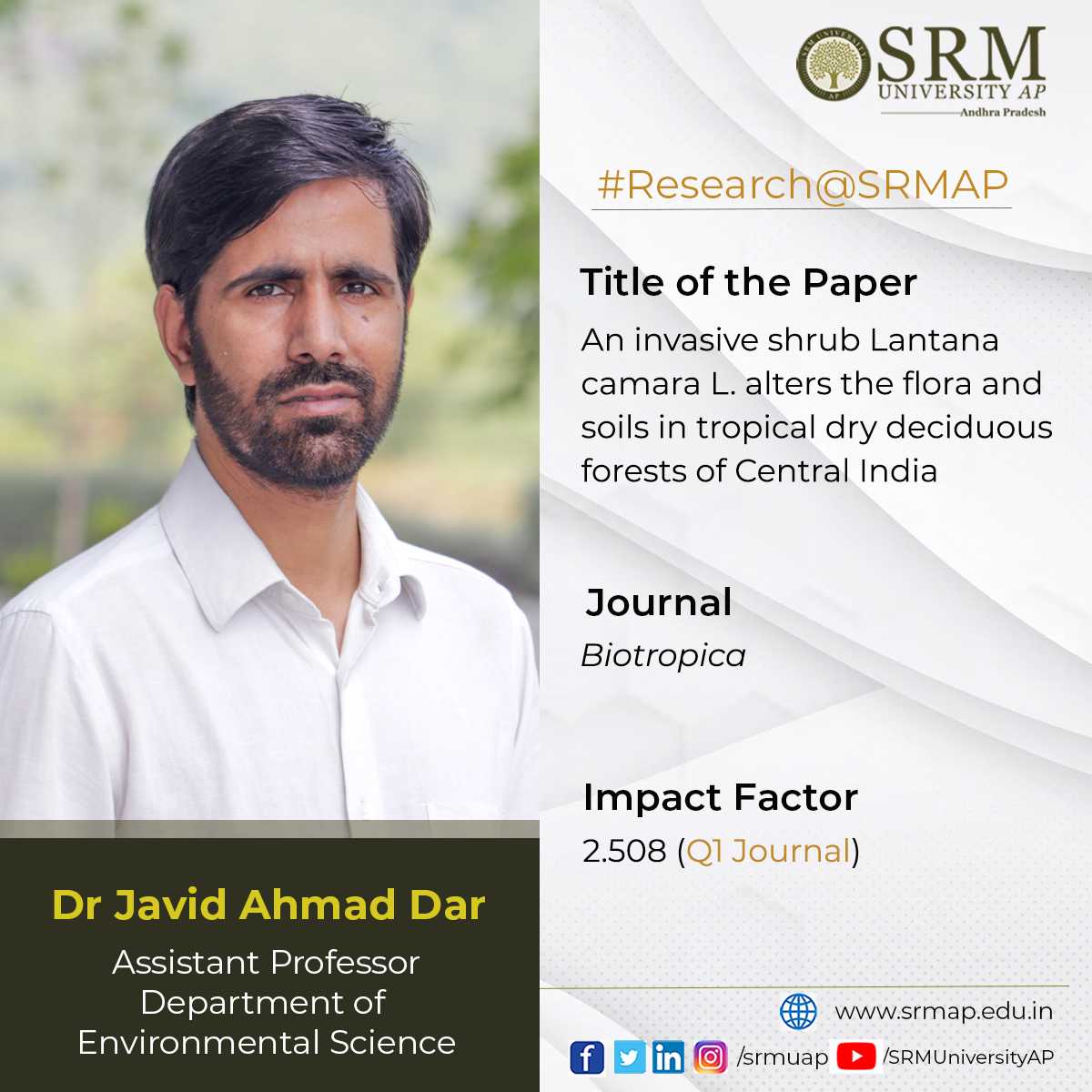 The paper titled “An invasive shrub Lantana camara L. alters the flora and soils in tropical dry deciduous forests of Central India” has been published by Dr Javid Ahmad Dar, Assistant Professor of Environmental Science at SRM University-AP, in “Biotropica” having an impact factor 2.508 (Q1 Journal).
The paper titled “An invasive shrub Lantana camara L. alters the flora and soils in tropical dry deciduous forests of Central India” has been published by Dr Javid Ahmad Dar, Assistant Professor of Environmental Science at SRM University-AP, in “Biotropica” having an impact factor 2.508 (Q1 Journal).
Abstract
The findings of this research reveal how an invasive shrub Lantana camara L. significantly alters the flora and soils in tropical dry deciduous forests of Central India and suggested long-term monitoring studies and proper management strategy.
Practical implementation
The findings would be helpful to forest managers, scientists and policymakers for better understanding, management, and restoration of the invaded landscapes in tropical forest ecosystems.
Collaborations
Prof M. L. Khan, Department of Botany, Dr Harisingh Gour Vishwavidyalaya (A Central University), Sagar, Madhya Pradesh, India.
Prof Raman Sukumar, Centre for Ecological Sciences, Indian Institute of Science (IISc), Bengaluru, India.
Prof Mukund Dev Behara, CORAL, Indian Institute of Technology, Kharagpur, West Bengal, India.
Prof S. M. Sundarapandian, Ecology and Environmental Sciences, Pondicherry University, Puducherry, India.
Future research plans:
Dr Javid Dar’s research plan for the next five years is to bring together several unique aspects of forest ecology which will be focused on carbon dynamics, mortality, microbial diversity and their relationship in shaping the structure and functional aspects of different forest ecosystems in the on-going and future climate change. Another major aspect of the research will be, to focus on ecophysiology and plant functional trait analysis in forest ecosystems as they are vulnerable to climate change and to see the impacts of climate change on diversity, productivity and stand structure in tropical and temperate forest ecosystems.
- Published in Departmental News, ENVS News, News, Research News
Dr Pankaj Pathak published articles on sustainable waste management
Dr Pankaj Pathak from the Department of Environmental Science has been keenly involved in research studies involving solid waste management and the effective conversion of wastes to energy. Her latest research publication ‘A comprehensive review on integrative approach for sustainable management of plastic waste and its associated externalities’ in the journal Science of the Total Environment (Impact Factor: 10.973) proposes enhanced solution for the sustainable management of plastic wastes. The article was published in collaboration with her PhD Scholar MSSR Tejaswini, Prof Sreeram Ramakrishna from the Centre for Nanofibers and Nanotechnology, National University of Singapore and Dr P Sankar Ganesh from BITS Pilani, Hyderabad.
Abstract of the Research
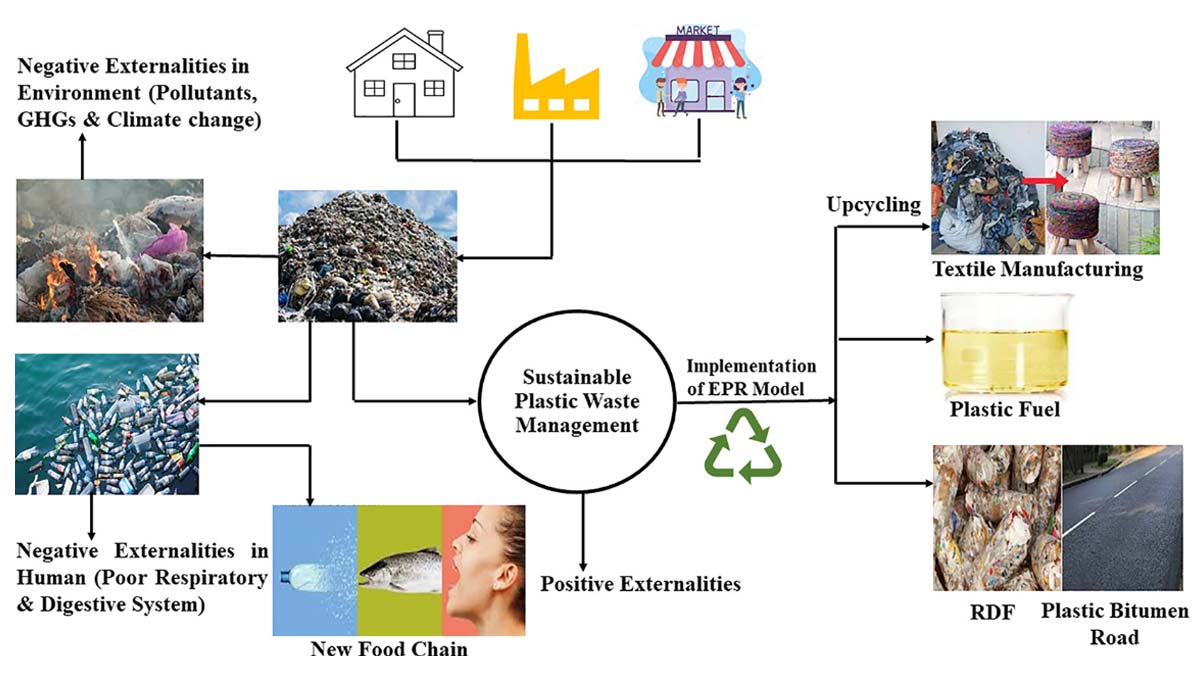
The management of post-consumer discarded plastic wastes (PCPW) creates new challenges in developing countries due to the lack of amenities, technological interventions, and associated negative environmental externalities. The fate of untreated recyclable and non-recyclable plastic wastes lies in open dumping along with other solid waste, and improper management leads to environmental externalities such as pollution, global climate change, and health issues. Additionally, open dumping upsurges the emerging microplastics and nano plastics (MNPs) contaminants. The externalities depend on the waste generating sources (household, industries, commercial), waste composition, and its characteristics. However, urban mining can minimize environmental externalities where waste plastics can convert into potential anthropogenic resources and also helps in achieving the target of sustainable development goals (SDGs 11 & 12). Moreover, various treatment technologies that help in the sustainable utilization of plastic wastes are extensively reviewed in this study and evaluate the costs benefits arising during various stages of treating plastic waste through recycling (R), incineration (I), and landfilling (L). The recycling of plastic waste has demonstrated the lowest impact on global warming potential (GWP) and total energy use (TEU), followed by landfilling and incineration (R < L < I). Nevertheless, when energy is recovered from inert (non-recyclable) plastic waste in the form of fuel or by its utilization in construction purposes, the environmental impacts are more negligible (Incineration < Landfilling). Therefore, this study determines the significance of circular economy with legislative approach and standards on plastic waste management, which help in reducing environmental externalities besides yielding a secondary resource as energy and materials through urban mining. A sustainable plastic waste management (SPWM) model is proposed for developing countries to convert plastic waste into resources and use it as a sustainable tool in urban mining.
Yet another article, ‘Comprehensive technological assessment for different treatment methods of leather tannery wastewater’, co- published by Dr Pankaj Pathak along with a group of other researchers was featured in the journal Environmental Science and Pollution Research having an Impact Factor of 5.19. The work offers some exhaustive observations and recommendations that could be helpful in the industry to manage tannery wastewater and recirculate the water in a sustainable manner.
Abstract of the Research
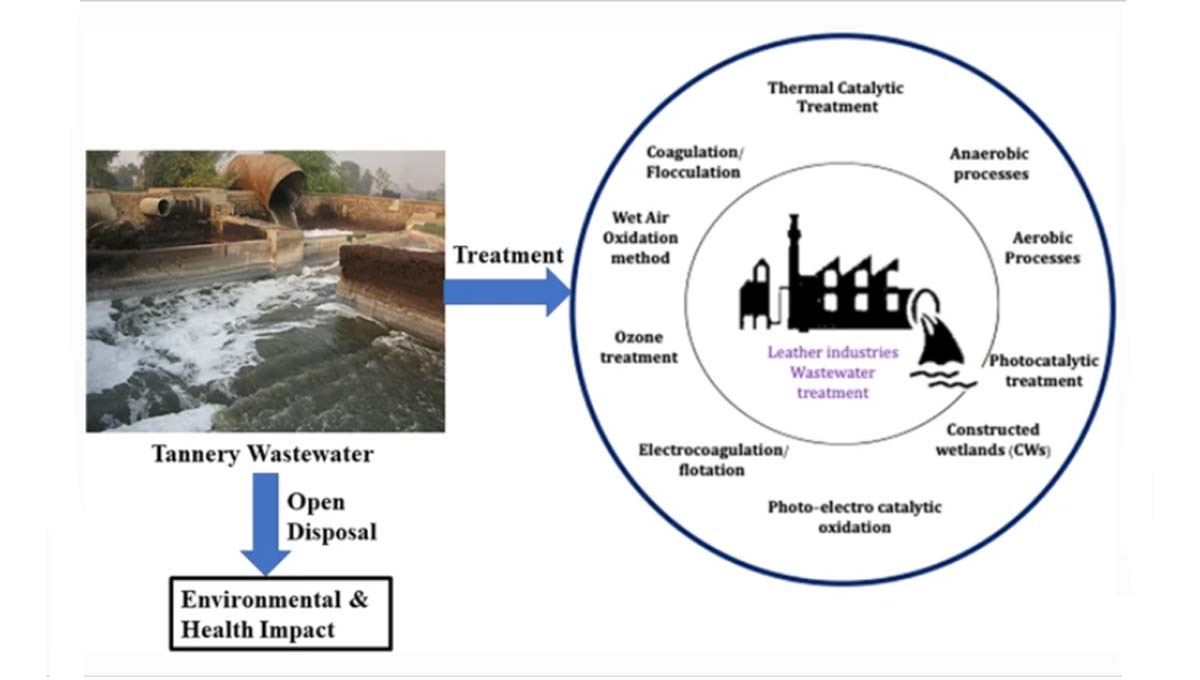
The leather-making process necessitates large amounts of water and consequently generates tons of liquid waste as leather tannery wastewater (TWW) is disposed of directly in the open environment. Open disposal of untreated TWW into the natural environment causes an accumulation of various polluting compounds, including heavy metals, dyes, suspended solids inorganic matter, biocides, oils, tannins, and other toxic chemicals. It thus poses potential hazards to the environment and human health. This study primarily focuses on providing in-depth insight into the characteristics, treatment strategies, and regulatory frameworks for managing TWW in leather processing industries. Different technologies of conventional physico-chemical (equalization, coagulation, and adsorption), advanced approaches (Fenton oxidation, ozonation, cavitation), thermo-catalytic and biological treatments available to treat TWW, and their integrative approaches were also highlighted. This review also sheds light on the most frequently applied technologies to reduce contaminant load from TWW though there are several limitations associated with it such as being ineffective for large quantities of TWW, waste generation during treatment, and high operational and maintenance (O&M) costs. It is concluded that the sustainable alternatives applied in the current TWW technologies can minimize O&M costs and recirculate the treated water in the environment. The exhaustive observations and recommendations presented in this article are helpful in the industry to manage TWW and recirculate the water in a sustainable manner.
- Published in Departmental News, ENVS News, News, Research News
Sustainable biorefinery approaches for a circular economy
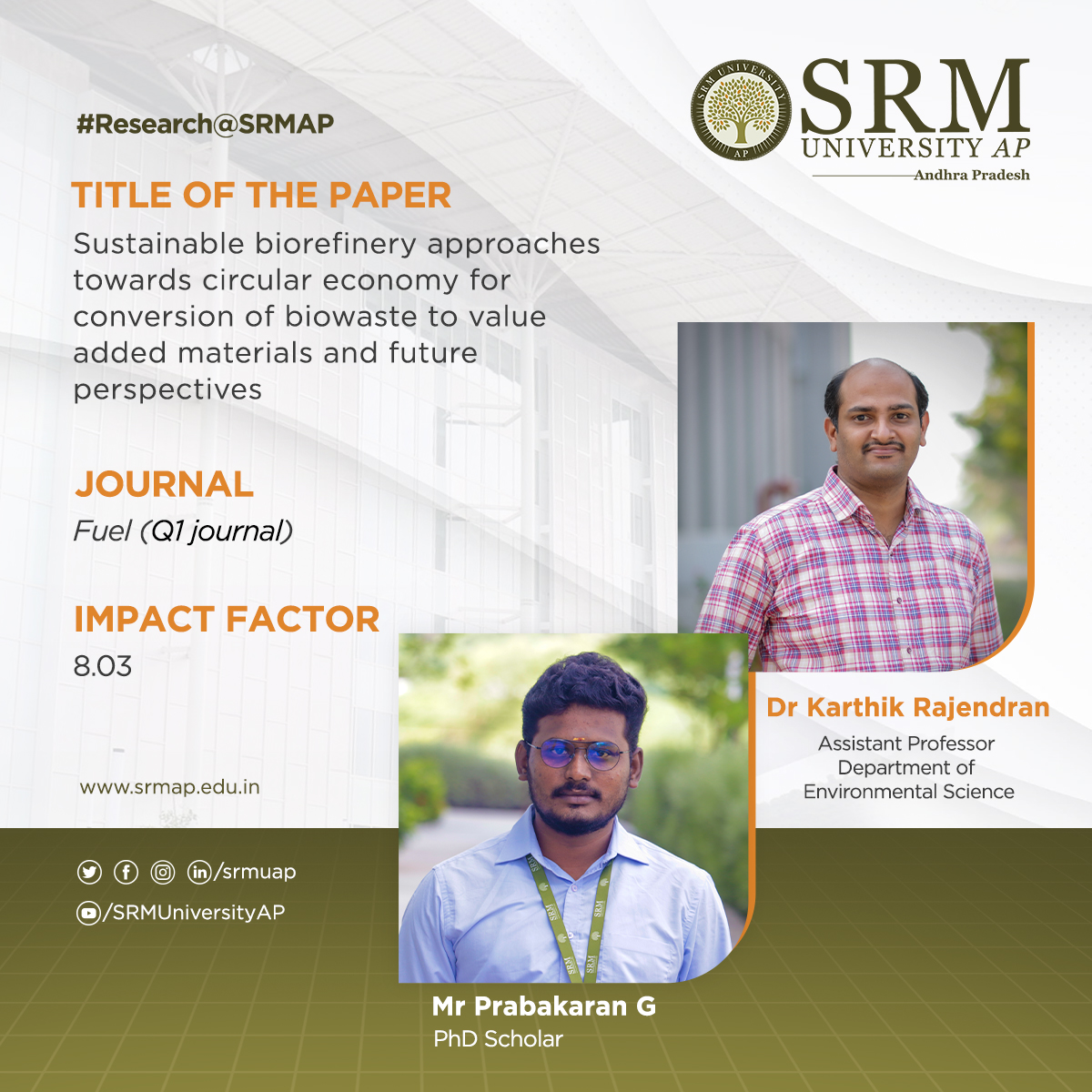 Worldwide, 1.3 billion tons of bio-waste are generated annually. By 2025, this is predicted to be increased by 2.2 billion tons/year. The emerged biowaste biorefinery has proved as a sustainable approach for integrated bioproducts, such as bioenergy, biopolymers, biochemicals, bioplastics, and biofertilizers further used for industrial, commercial, agricultural, and energy applications. Integrating biorefinery concepts into biowaste management is promising for a circular bioeconomy. Recent research at the Department of Environmental Sciences investigates the potential of sustainable biorefinery approaches. Assistant professor Dr Karthik Rajendran and his PhD scholar Mr. Prabakaran G published a paper, Sustainable biorefinery approaches towards circular economy for conversion of biowaste to value added materials and future perspectives, in Fuel, a Q1 journal, with an impact factor of 8.03. For this paper, they have collaborated with Dr Mukesh Kumar Awasthi from the College of Natural Resources and Environment, Northwest A&F University, China.
Worldwide, 1.3 billion tons of bio-waste are generated annually. By 2025, this is predicted to be increased by 2.2 billion tons/year. The emerged biowaste biorefinery has proved as a sustainable approach for integrated bioproducts, such as bioenergy, biopolymers, biochemicals, bioplastics, and biofertilizers further used for industrial, commercial, agricultural, and energy applications. Integrating biorefinery concepts into biowaste management is promising for a circular bioeconomy. Recent research at the Department of Environmental Sciences investigates the potential of sustainable biorefinery approaches. Assistant professor Dr Karthik Rajendran and his PhD scholar Mr. Prabakaran G published a paper, Sustainable biorefinery approaches towards circular economy for conversion of biowaste to value added materials and future perspectives, in Fuel, a Q1 journal, with an impact factor of 8.03. For this paper, they have collaborated with Dr Mukesh Kumar Awasthi from the College of Natural Resources and Environment, Northwest A&F University, China.
Biorefinery is designed to improve the economic potential and achieve a circular bioeconomy by integrating various technologies such as pyrolysis, anaerobic digestion, gasification, incineration, and aerobic composting to gain energy, nutrients, and material recovery. Biowaste biorefinery contributes as a driving force to cope with challenges of resource scarcity, climate changes, and increased demand. The sustainable biorefinery approaches toward circular bioeconomy require a comprehensive understanding of the biowaste across the value chain. Based on the carbon neutralized biowaste biorefinery concept, this paper explained biowaste generation and utilization as a renewable resource through biorefinery techniques from the perspective of energy, nutrients, and material recovery. Meanwhile, clarify the implementation status, public engagement, and prospects of biowaste recycling with the central concept of biorefinery circular bioeconomy.
Abstract
With the colossal energy demand inevitably exacerbating the non-renewable resources depletion and ecological-social challenges, renewable energy has become a crucial participant in sustainable strategy. Biorefinery emerged as a sustainable approach and recognized promising transformation platforms for products to achieve a circular bioeconomy that focuses on biomass efficiency and sustainable valorisation, promotes resource regeneration, and restorative. The emerged biowaste biorefinery has proved as a sustainable approach for integrated bioproducts and further applied this technology in industrial, commercial, agricultural, and energy sectors. Based on carbon-neutral sustainable development, this review comprehensively explained biowaste as renewable resource generation and resource utilisation technologies from the perspective of energy, nutrient, and material recovery in the concept of biorefinery. Integrating biorefinery concepts into biowaste management is a promise for the conversion of biowaste into value-added materials. It contributes as a driving force to cope with resource scarcity, climate changes, and huge material demand in a circular bioeconomy. In practice, the optimal of biorefinery technologies depends on environmentally friendly, economic and technical feasibility, and social and policy acceptance. Additionally, policy interventions are necessary to promote biowaste biorefinery implements for a circular bioeconomy and contribute to a low-carbon cleaner environment.
- Published in Departmental News, ENVS News, News, Research News
Biowaste valorisation for environmental remediation
Rampant exploitation of resources has indisputably contributed to an enormous rise in solid waste generation. It has been estimated that solid waste generation will shoot up from 1.3 billion tons to 2.2 billion tons in 2025. While 16% of the high-income countries’ population corresponds to 34% of waste being generated, only 5% of the waste generated is attributed to the low-income countries. However, it is a meagre volume of 39% that is collected leaving the rest to rot. This open dumping affects the environment and creates pollution. In addition, improper waste disposal techniques have resulted in emissions of 1.6 billion tons of CO2eq in 2016. Effective waste management is thus a matter of concern in third-world countries.
Assistant Professor Dr Karthik Rajendran and his post-doctoral scholar Dr V S Vigneswaran from the Department of Environmental Science in collaboration with Dr Mukesh Kumar Awasthi from the College of Natural Resources and Environment, Northwest A&F University, PR China, have published their research papers on solid waste management in the journal Bioresource Technology having an Impact Factor of 11.8. This is the second-best journal in the Environmental Engineering category according to SCImago Journal Rank (SJR). The journal aims to disseminate knowledge in the areas of biomass, biological waste treatment, bioresource systems analysis, and technologies associated with conversion or production.

The paper titled “Recovery of value-added products from biowaste: A review” introduces microbial biotechnology for the valorisation of solid wastes. Microbial biotechnology offers several solutions for the utilisation of waste resources. The carbon present in solid and gaseous wastes can be utilised by the microbes as carbon feedstock for their growth. During the growth of microbes on wastes, it produces primary and secondary metabolites, which are of significant use to humankind. The microbes can also be engineered biotechnologically to use waste resources and produce new compounds. Microbial biotechnology, with the use of various genetic engineering tools, can be efficiently explored for the microbes’ modification to utilise different wastes thereby making the environment clean by reducing GHG emissions.
Abstract of the Research
This review provides an update on the state-of-the art technologies for the valorization of solid wastes and its mechanism to generate various bio-products. The organic content of these wastes can be easily utilized by the microbes and produce value-added compounds. Microbial fermentation techniques can be utilized for developing waste biorefinery processes. The utilization of lignocellulosic and plastic wastes for the generation of carbon sources for microbial utilization after pre-processing steps will make the process a multi-product biorefinery. The C1 and C2 gases generated from different industries could also be utilized by various microbes, and this will help to control global warming. The review seeks to expand expertise about the potential application through several perspectives, factors influencing remediation, issues, and prospects.

Food waste in solid forms has been generated throughout the entire food life cycle, from the agricultural production process to the distribution of processed foods and even to their consumption in the market. Considering that approximately 1.3 billion tons of edible food waste is leftover annually, recycling it in the biorefinery will contribute both economically and socially. Another of their publication “Myco-biorefinery approaches for food waste valorization: Present status and future prospects” discusses various types of food waste sources and their evaluation targets. Food waste can be evaluated in fungi-based bioproduction processes for this purpose. In addition, potential biorefinery systems, circular bioeconomy processes, techno-economic studies, and social/ethical aspects of food wastes in the evaluation of valuable products are discussed.
Abstract of the Research
The increase in population and urbanization leads to the generation of a large amount of food waste (FW) and its effective waste management is a major concern. Its putrescible nature and high moisture content are the major limiting factors for cost-effective FW valorization. Bioconversion of FW for the production of value-added products is an eco-friendly and economically viable strategy for addressing these issues. Targeting the production of multiple products will solve these issues to a greater extent. The article provides an overview of the bioconversion of FW to different value-added products.
- Published in Departmental News, ENVS News, News, Research News
Sustainable strategies for solid waste management
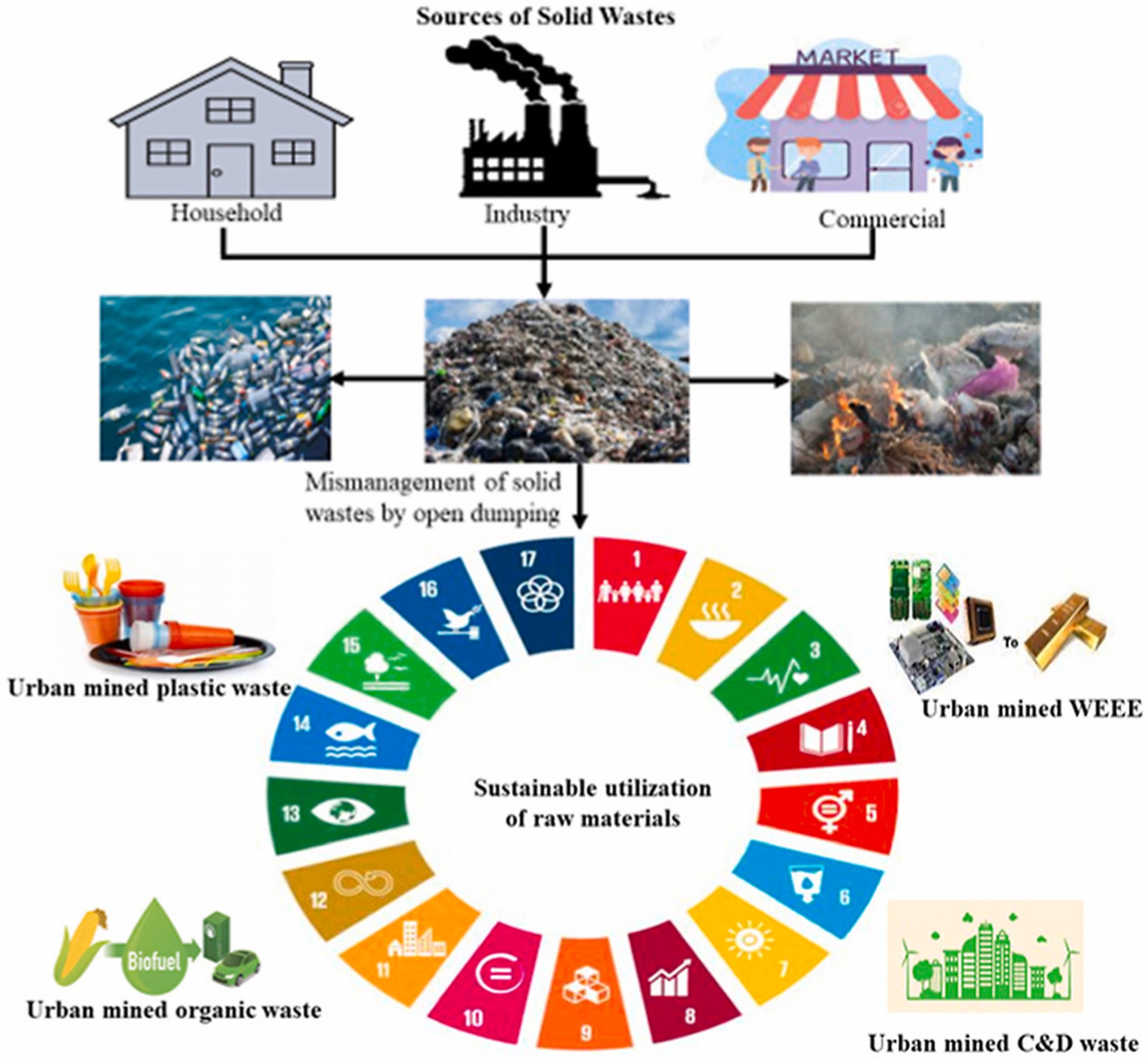 Dr Pankaj Pathak from the Department of Environmental Science has been keenly involved in research studies involving solid waste management and the effective conversion of wastes to energy. Her latest research publication Sustainable approach for valorization of solid wastes as a secondary resource through urban mining proposes an enhanced solution for the sustainable management of different types of solid wastes. It was published in the Journal of Environmental Management with an impact factor 8.98.
Dr Pankaj Pathak from the Department of Environmental Science has been keenly involved in research studies involving solid waste management and the effective conversion of wastes to energy. Her latest research publication Sustainable approach for valorization of solid wastes as a secondary resource through urban mining proposes an enhanced solution for the sustainable management of different types of solid wastes. It was published in the Journal of Environmental Management with an impact factor 8.98.
In this paper, sustainable alternative valorisation techniques that aid in maximum recovery from waste materials, and associated challenges and limitations have been highlighted. These solid wastes mainly include construction and demolition wastes, organic food wastes, plastic, and WEEE (Waste electrical and electronic equipment) from various sources. In order to overcome these challenges, a sustainable circular model is recommended in this paper that will help minimise the negative environmental impacts, maximise the life cycle of material, reduce the consumption of fossil fuels, and thereby sustainably manage waste. Implementation of this recommendation can help in achieving the target of sustainable development goals (SDGs).
The article was published in collaboration with her PhD Scholar MSSR Tejaswini, and D.K. Gupta, Member Secretary in the Hazardous Substance Management Division in the Ministry of Environment, Forest and Climate Change, New Delhi.
Abstract
The incessant population has increased the production and consumption of plastics, paper, metals, and organic materials, which are discarded as solid waste after their end of life. The accumulation of these wastes has created growing concerns all over the world. However, conventional methods of solid waste management i.e., direct combustion and landfilling have caused several negative impacts on the environment (releasing toxic chemicals and greenhouse gases, huge land use) besides affecting human health. Therefore, it is requisite to determine sustainable alternative technologies that not only help in mitigating environmental issues but also increase the economic value of the discarded solid wastes. This process is known as urban mining where waste is converted into secondary resources and thereby conserves the natural primary resources. Thus, this review highlights the technological advancements in the valorisation process of discarded wastes and their sustainable utilization. We also discussed several limitations of the existing urban mining processes and further the feasibility of valorisation techniques was critically analysed from a techno-economical perspective. This paper recommends a novel sustainable model based on the circular economy concept, where waste is urban mined and recovered as a secondary resource to support the united nations sustainable development goals (SDGs). The implementation of this model will ultimately help the developing countries to achieve the target of SDGs 11, 12, and 14.
- Published in Departmental News, ENVS News, News, Research News
Effect of grass clippings on anaerobic co-digestion of food waste
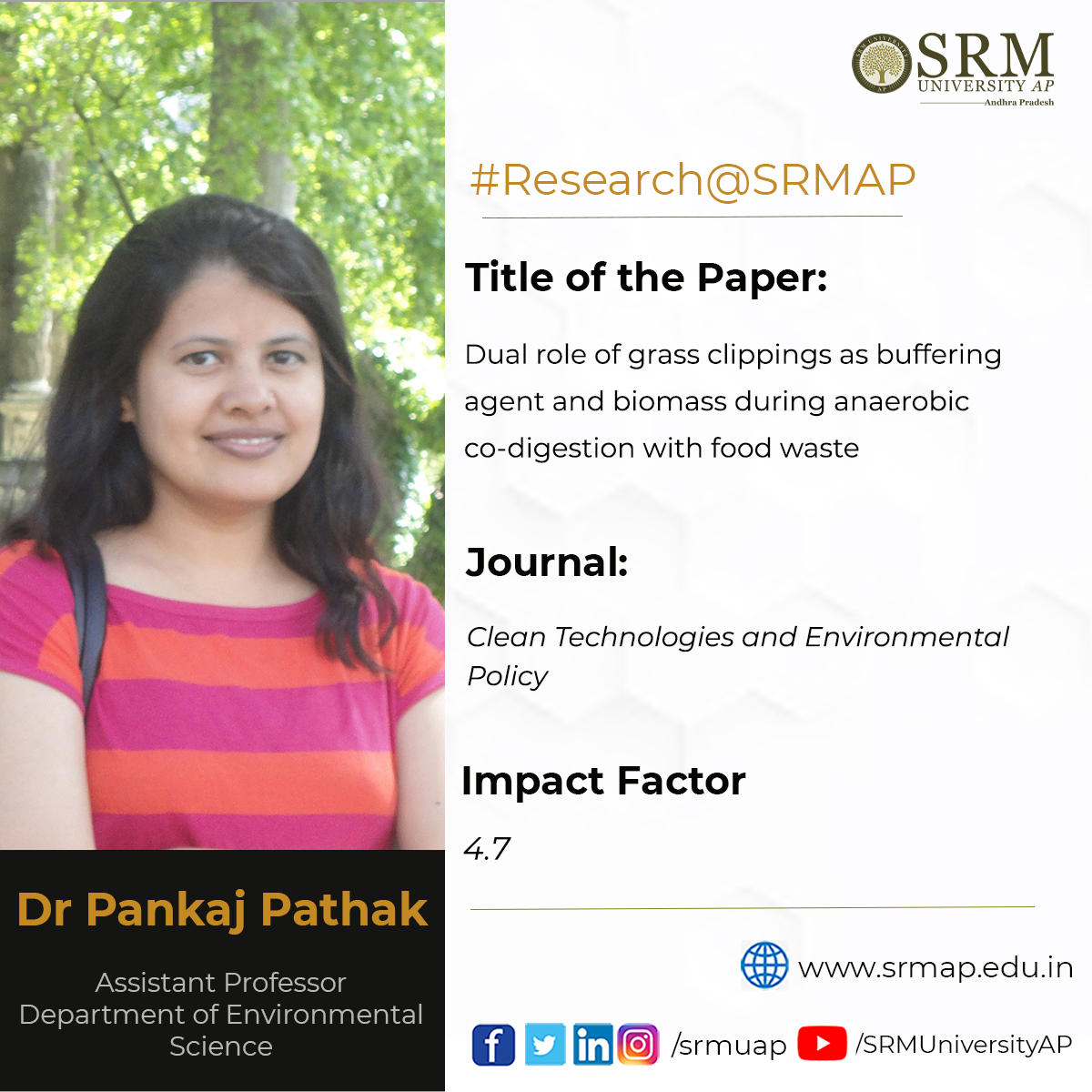 The different dimensions of sustainable waste management have always been explored by researchers all over the world. Assistant Professor Dr Pankaj Pathak, Department of Environmental Science, has been actively involved in this research area for a while. Her paper titled Dual role of grass clippings as buffering agent and biomass during anaerobic co digestion with food waste is published in the journal Clean Technologies and Environmental Policy with an impact factor 4.7. Dr Pankaj Pathak co-authored the paper with Debkumar Chakraborty, Sankar Ganesh Palani, M M Ghangrekar, and N Anand.
The different dimensions of sustainable waste management have always been explored by researchers all over the world. Assistant Professor Dr Pankaj Pathak, Department of Environmental Science, has been actively involved in this research area for a while. Her paper titled Dual role of grass clippings as buffering agent and biomass during anaerobic co digestion with food waste is published in the journal Clean Technologies and Environmental Policy with an impact factor 4.7. Dr Pankaj Pathak co-authored the paper with Debkumar Chakraborty, Sankar Ganesh Palani, M M Ghangrekar, and N Anand.
Abstract
There is a dire need to replace the chemical buffers that regulate the redox environment in single-stage anaerobic digestion of food waste. Hence, the applicability of grass clippings as an eco-friendly buffering agent and biomass during the anaerobic co-digestion of food waste was explored. A focus was primarily given on the effects of grass clippings on the redox environment and acidogenesis. Concomitantly the production of volatile fatty acids, hydrogen, and methane in mesophilic conditions was monitored. Organic load and substrate-to-inoculum ratio were kept constant in all the experiments, and no chemical buffer was used. The results revealed that the redox environment was regulated with 10% grass clippings by inhibiting rapid pH drop in the digester. The addition of 2, 4, and 6% grass clippings promoted acidogenesis with increased production of acetic and butyric acids, whereas 8 and 10% grass clippings promoted solventogenesis with ethyl alcohol production. Hydrogen generation from the experiments with grass clippings was in the range of 27–30% of the total biogas, which was marginally higher than the control (25%). Methane concentration was negligible in the biogas generated from all experiments. The acidification rate, VFA production/consumption rate, specific hydrogen yield, hydrogen conversion efficiency, and volatile solids removal were maximum and minimum in the reactors with 6 and 10% grass clippings, respectively. From the above results, it can be concluded that adding grass clippings to food waste would regulate the sudden pH changes and enhance the production of value-added biochemicals, making the process cost-effective.
- Published in Departmental News, ENVS News, News, Research News
Dr Pankaj Pathak co-edited and authored in the springer publication series
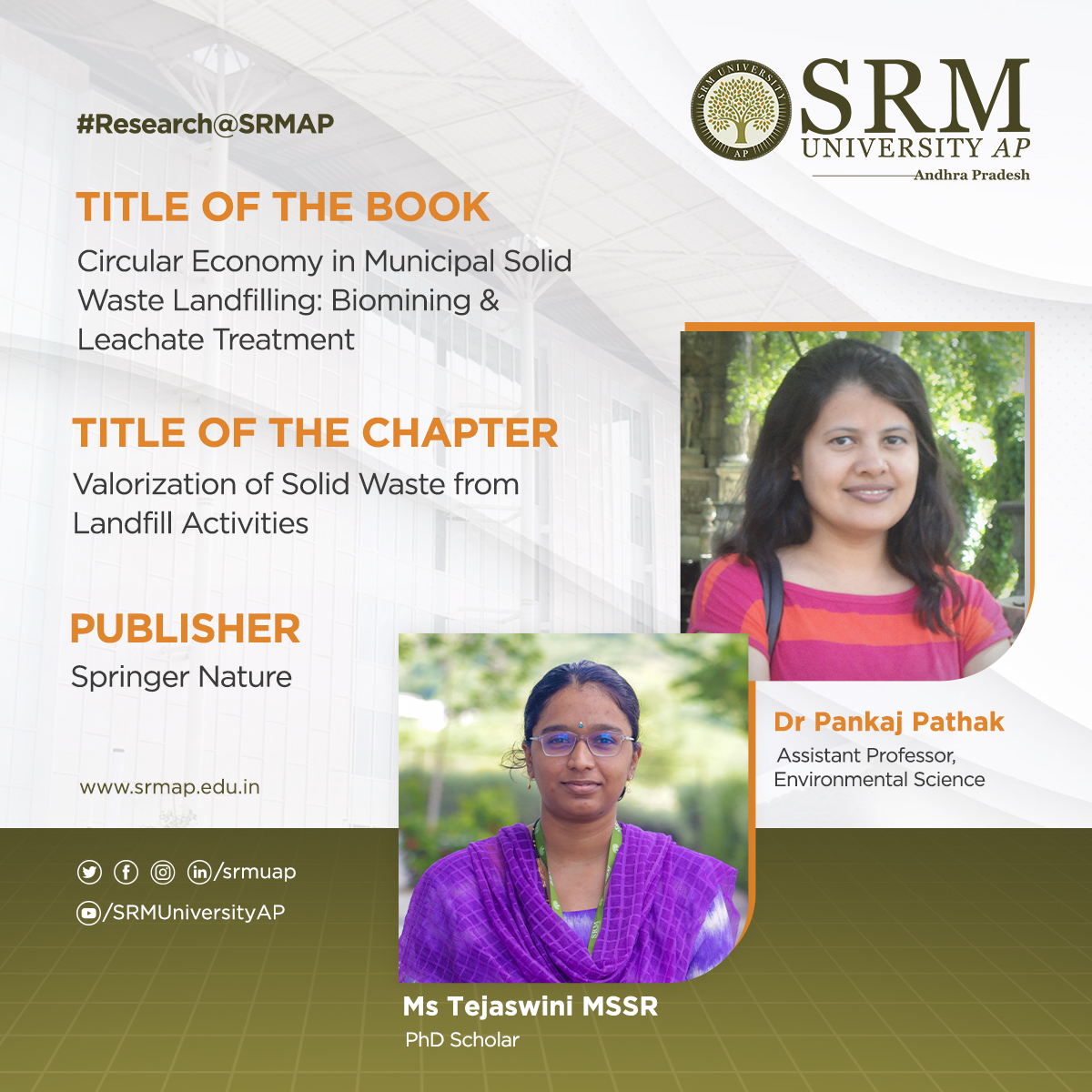
Dr Pankaj Pathak, Assistant Professor, Department of Environmental Science co-edited the book “Circular Economy in Municipal Solid Waste Landfilling: Biomining & Leachate Treatment: Sustainable Solid Waste Management: Waste to Wealth” in collaboration with Prof Sankar Ganesh Palani from BITS Pilani, Hyderabad. The book was released as part of the Springer publication series ‘Radionuclides and Heavy Metals in the Environment’ that covers issues pertaining to environmental pollution of air, water and soil, causative toxic agents, including radioactive materials, and remediation strategies.
The book is a ready reckoner of contemporary information regarding municipal solid waste landfill biomining, treatment of landfill leachate and heavy metals in a single platform. Construction of new landfills which requires huge monetary investments can be avoided if old landfills were bio-mined for resources and the space can be re-used as new landfills. Landfill leachate is a hazardous waste which needs proper treatment that could generate value-added products such as clean energy and biofertilizers. The book is a rich repository of information for academicians, researchers, and students at master’s and doctoral levels to understand the current trends in municipal solid waste landfill operations.
It also features the chapter, ”Valorization of Solid Waste from Landfill Activities” co-authored by Dr Pankaj Pathak and her PhD scholar MSSR Tejaswini along with Prof Sankar Ganesh Palani and Dr Prangya Ranjan Rout from Thapar Institute of Engineering and Technology. The article states that urban mining of various types of landfill wastes helps in the conservation of natural resources as well as increases the economic value of the disposed of wastes. It also ensures maximum recovery from the wastes that can be used as a secondary raw material for production purposes. Accordingly, they determine the environmental impacts associated with landfill wastes and identify different technologies that would help in the conversion of waste into resources through urban mining.
Essentially the book provides a circular economy approach to municipal solid waste (MSW) management. It also reviews the current technologies and future trends in MSW treatment by focusing on technological solutions for MSW treatment in developing countries in comparison with developed countries.
- Published in Departmental News, ENVS News, News, Research News
Modified solar air heater for preserving agricultural produce

There is a growing demand for decentralised systems that use renewable energy to extend the shelf life of agricultural commodities. Solar Air Heating systems (SAHs) are effective and environmentally friendly systems used to preserve agricultural produce by lowering the moisture content. Assistant Professor Dr Karthik Rajendran and his Post-Doctoral Scholar Dr VS Vigneswaran from the Department of Environmental Science have published their paper “Augmented v-corrugated absorber plate using shot-blasting for solar air heater – Energy, Exergy, Economic, and Environmental (4E) analysis” in the Q1 journal “Process Safety and Environmental Protection” having an Impact Factor of 7.9. The paper was published in collaboration with D. Sung Chul Kim, Shandong University, China.
South Asia is home to the majority of the world’s hungry people. Among 116 nations, India, the second-most populated nation in the world, is ranked 101st in the global hunger index. There is cause for concern given that India loses over 67 million tonnes of food annually, which is equivalent to about Rs. 92,000 crore. In 2016, the Indian Council of Agricultural Research estimated that during harvest, post-harvest, processing, and storage, about 4.3-6.1% of pulses, 3.9-6% of grains, 2.8-10.1% of oilseeds, 6.9-13% of vegetables, and 5.8-18.1% of fruits were lost. 16% of fruits and vegetables as well as 10% of oilseeds, pulses, and cereals were lost in India due to inadequate access to storage facilities.
Each year, these losses increase in India. In order to reduce food wastage after harvest and the amount of people going hungry in India, technologies must be developed to extend the shelf life of agricultural produce. The utilisation of land, water, energy, and the release of greenhouse gases into the atmosphere can all be decreased by reducing postharvest loss. It is necessary to develop a decentralised system that uses renewable energy to extend the shelf life of agricultural products. Given that the majority of India has abundant solar energy resources, solar crop dryers based on solar air heaters (SAH) are a practical choice for conserving agricultural output by lowering its moisture content. These technologies are appealing because they are affordable and sustainable.
The performance of SAH is determined by the absorber plate. Thus, the SAH was modified with a v-corrugated absorber plate with a shot-blasted surface, and the SAH performance was investigated experimentally. Performance parameters including the energy and exergy efficiency of the collector were determined and compared with those of the conventional SAH. The study inferred that SAH optimisation will make way for the maximisation of its efficiency.
Abstract of the Research
Need for increasing the shelf life of agricultural produce using renewable energy-based A decentralized system are significantly increasing. The solar air heating systems (SAHs) are efficient and environment friendly systems which are used for preserving agricultural produce through the reduction of moisture content. However, these systems had poor thermal efficiency and the way for increasing the efficiency are much need in the present era. This article presents the energy, exergy, and economic analysis of a modified solar air heater system (SAH). The proposed (modified) SAH has a V-corrugation absorber plate; the inner surface was modified using shot-blasting technology. This is the first study to experimentally investigate a modified SAH and compare the results with those of a conventional SAH. Additionally, an environmental and sustainability assessment of the SAH is presented. The SAH performance was tested at airflow rates ranging from 0.01 to 0.02 kg. sec.
- Published in Departmental News, ENVS News, News, Research News
Occurrence, environmental risks, and biological remediation of Triclosan
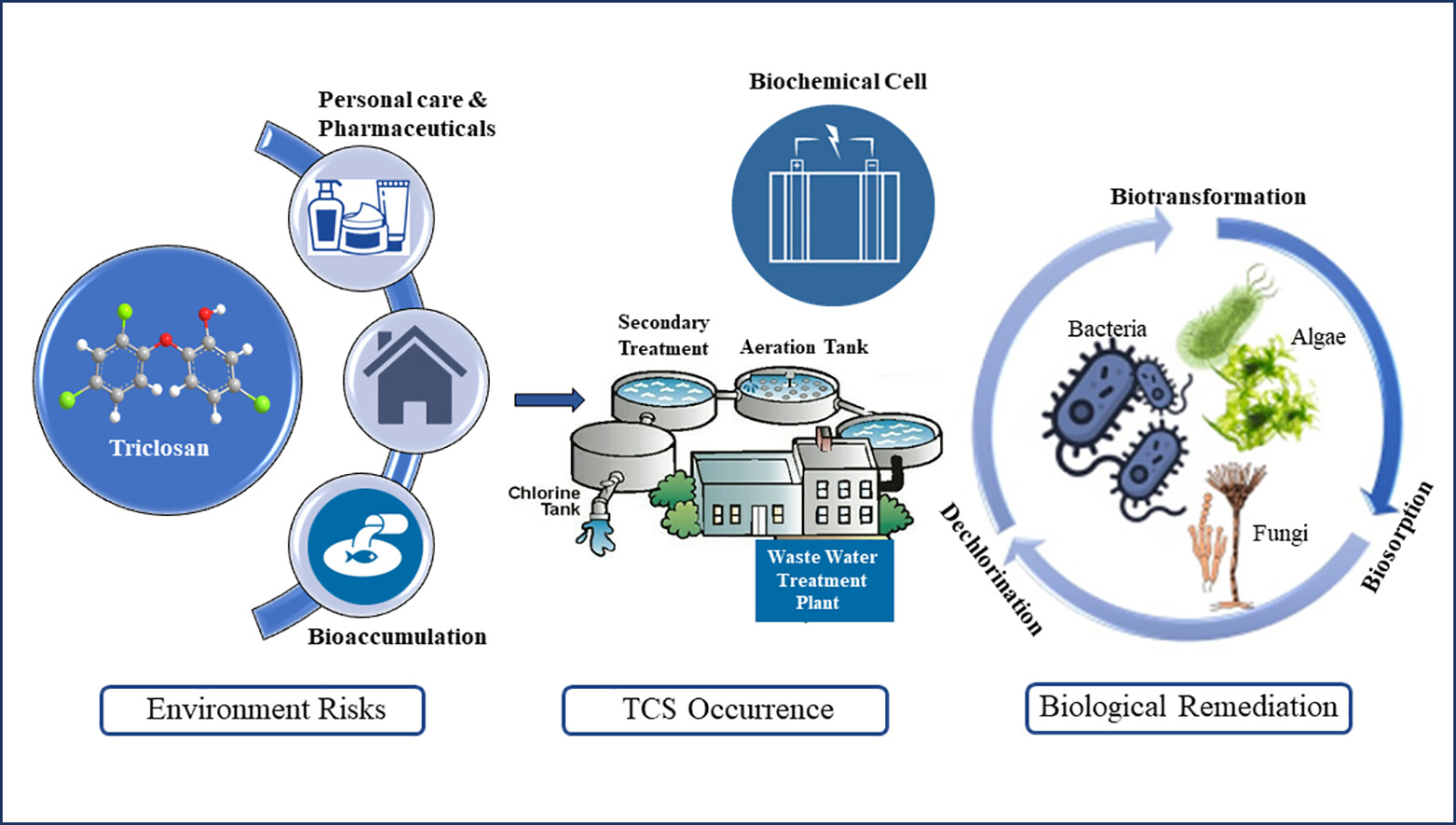
The Department of Environmental Science is glad to announce that Assistant Professor Dr Pankaj Pathak and her PhD Scholar Mr Gopa Nandikesh have published an article titled “Occurrence, environmental risks and biological remediation mechanisms of Triclosan in wastewaters: Challenges and perspectives” in the Journal of Water Process Engineering having an Impact Factor 7.34. The paper was published in collaboration with Dr Lakhveer Singh, Sardar Patel University, Himachal Pradesh.
The paper makes a comprehensive understanding of the disadvantages and consequences associated with the excessive use of Triclosan (TCS), an anti-microbial agent widely used in pharmaceutical and personal care products (PPCPs). The article also suggests various ways to achieve the bioremediation of Triclosan using microbial degraders and the different challenges associated with such practices.
The extensive use of TCS in PPCPs has increased over the past few decades, and its sizeable production and consumption are causing adverse effects on the environment and humans. TCS has been made into the list of emerging micropollutants (EMPs) due to its omnipresence in water resources and even in biological samples such as urine and breast milk. Therefore, it is imperative not only to understand the current status of TCS pollution but their occurrence, exposure routes, and environmental risks to identify remediation technologies for mitigating TCS.
Their research targets to provide cumulative data on the abundance of emerging TCS in water resources and its associated health burdens simultaneously. It is identified that TCS remediation can be achieved through advanced physical and chemical methods such as enzyme oxidation and ozonation. However, there are drawbacks such as high energy consumption and the formation of toxic by-products.
The article endeavours to provide an in-depth understanding of the biological remediation of TCS by microbial degraders as well as its superiority over other remediation techniques. Insights into the various microbial communities such as bacteria, algae, and fungi and their unique bioremediation mechanisms are comprehensively summarised. Moreover, challenges associated with existing bioremediation methods and future perspectives are also discussed in the present work.
- Published in Departmental News, ENVS News, News, Research News
Study on C and N dynamics in response to climate change
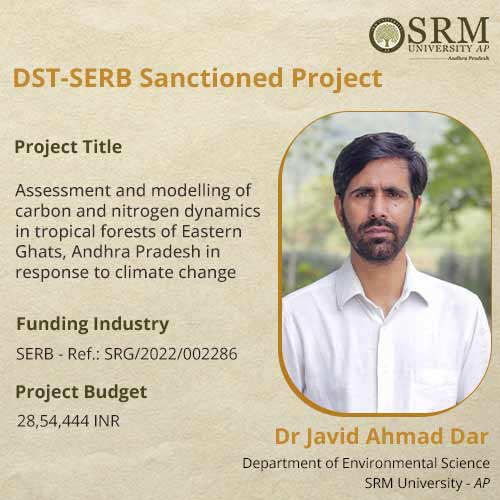 Tropical forests are the breathing lungs of the world that work as a collective to stabilise climate by absorbing vast amounts of carbon dioxide. Covering over 12% of Earth’s total land surface. It functions as a harbour for evolution and supplying prerequisite rainfall for healthy vegetation. Recent global climate changes have catalysed drastic effects on the tropical forests and the healthy functioning of the same. A critical understanding of the present state of forest ecosystems is crucial for undertaking necessary measures to prevent further degradation.
Tropical forests are the breathing lungs of the world that work as a collective to stabilise climate by absorbing vast amounts of carbon dioxide. Covering over 12% of Earth’s total land surface. It functions as a harbour for evolution and supplying prerequisite rainfall for healthy vegetation. Recent global climate changes have catalysed drastic effects on the tropical forests and the healthy functioning of the same. A critical understanding of the present state of forest ecosystems is crucial for undertaking necessary measures to prevent further degradation.
Recently, the project entitled Assessment and modelling of carbon and nitrogen dynamics in tropical forests of Eastern Ghats, Andhra Pradesh in response to climate change, has been sanctioned to Dr Javid Ahmad D, Assistant Professor, Department of Environmental Science by DST – SERB (Science and Engineering Research Board), Govt of India, with a total outlay of Rs. 28.54 lakhs. Dr Javid Ahmad D is the principal investigator of the project.
A complete dataset on long-term dynamics in vegetation, the C and N generated for different tropical forest types in the Eastern Ghats landscape would serve as a baseline data for forest managers and policy-makers. The project aims to gain insight on the response of these tropical forests to changing global climate in relation to multiple factors (elevated CO2, increased temperatures and altered precipitation).
- Published in Departmental News, ENVS News, News, Research News

